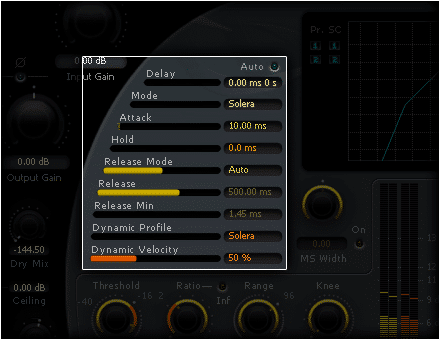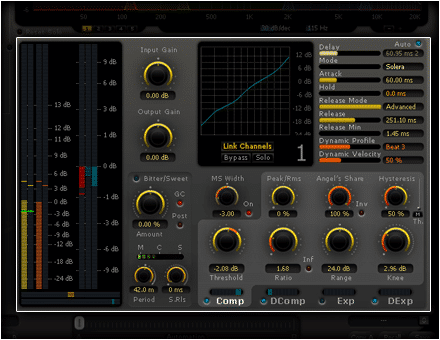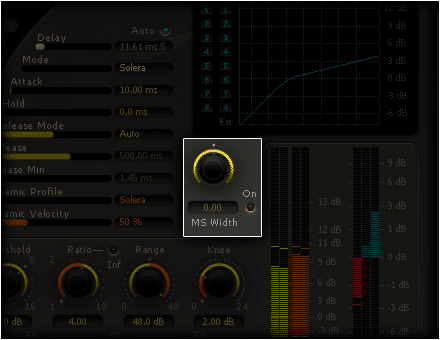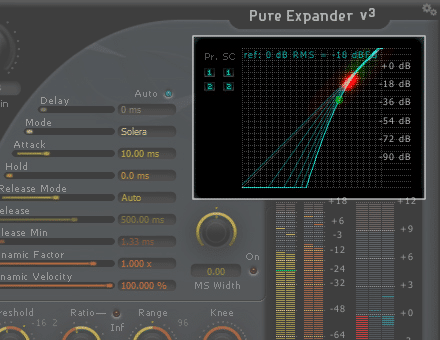Product Description
Clean Up Your Mix
Pure Expander, capable of anything from mild expansion to hard noise-gating, is a versatile tool for cleaning up spillage from recordings, remove noise or reverb, leakage from drum sessions or microphone bleed. By reducing the gain below threshold, it gives you full control over the material making it easy to tighten up the mix and reduce any unwanted low-lever clutter.
All Features
- Up to 8 channels Input/Output
- Generous -/+ 48 dB input/output gain range
- Input/Output gain controls for adjusting the levels before and after processing
- Dry/wet control offering true parallel dynamics processing and for blending some of the original “peak” into the processed signal
Preset and Parameter Handling
- Preset/Parameter slots To enhance the workflow the two Preset/Parameter slots, A and B, can be loaded with two full set of parameters at the same time. Apart from saving each preset, a “Global Preset” containing both the A and B settings, and the position of the “Morphing Slider”, can be saved.
Compatibility







Full control over the processing
.
In addition to the common controls on a dynamics processor; ratio, attack, release, Pure Expander offers control over the fundamental characteristics of the dynamics processing, all in order to provide full control over the processing even in the most demanding situations.
Envelope, Time and Detection Settings
- Extended envelope settings with full control of Attack, Hold and Release with Manual, Auto and Advanced release modes.
- Zero attack time for the dynamics processing by introducing a delay reflecting the attack time into the signal path.
- Eight different detection modes interacting with the time and envelope settings as well as with the integration times for the RMS detection. Includes specific “Feed Backward” modes inspired by vintage hardware architectures for producing a naturally “beefy” sound.
- Dynamic Factor – Amplifies or diminishes the extracted real-time dynamics information.
- Dynamic Velocity – Controls the speed of variation on the extracted dynamics information.
Open up the sound and increase the dynamic impression
.
Two parameters are provided that are kind of unique to dynamics processing; Dynamics Ratio and Level Independent Detection (L.I.D), using the dynamic range content of the signal and not just the signal levels as standard processors do.
- Dynamics Ratio is controlling the amount of auto-ratio determined by the signal dynamics and the manual ratio setting. This literally opens the sound, increases the dynamic impression and keeps some crest by adjusting, in real time, the ratio of every dynamic processing section in regards to both the current ratio settings and the signal content (mainly dynamic range).
- Level Independent Detection (L.I.D) controls the amount of auto-threshold determined by the signal dynamics and the manual threshold value, providing processing of the audio signal independently of the sound level and instead in regards to the signal dynamic range.
- A Maximum mode can be engaged on the L.I.D control, allowing for processing that accounts for the maximum values of both the standard and the L.I.D detection schemes.
Control the Stereo width of your mix
.
To control the actual Stereo width of the mix a built-in MS encoder/decoder is used to split the stereo-signal in its M and S components in order to control the actual stereo width of the mix.
The MS Width Control – Sets the stereo width of the processed signal. A -6 dB value deceases the stereo width. A +6 dB value increases the wideness of the stereo mix but can produce phase issue.
The MS Mode Control – Enables one MS encoding matrix at the input and one MS decoding matrix at the output of the dynamic processing in order to control the stereo width of the mix. When engaged, the side chain is fed by a MS encoded signal that is reflected in the display section. M channel corresponds to the normal left channel. And the S channel corresponds to the normal right channel.
(This feature is only available when two channels (no more, no less) are processed.)
Individual Multichannel Processing
.
Up to eight channels of simultaneous processing for multichannel surround configuration is provided. The processing can be disengaged on any of the channels leaving the material unprocessed, bypassing the original sound.
When operating on a multi-channel bus all, up to eight in total, channels are processed by default, though the processing can be disengaged for any number of channels leaving the material unprocessed and bypassing the original sound.
By doing this in combination with serial instances the material on any number of channels can be processed with individual settings.
Dual Preset Slots and Parameter Morphing
.
The built in preset manager and the preset morphing slider, provides instant and intuitive control of all parameters and controls. In a second, with a simple one-click operation, everything is copied from one of the two preset slots to the other, even during playback.
The two Preset/Parameter slots, A and B, can be loaded with two full set of parameters at the same time, and except for only A/B comparing two sets of parameters, the morphing slider will allow to mix them, and to record the morph with the host automation.
Specifications
Flux:: Plugin Specifications
OS Compatibility
- Windows 10 – 64bit and the latest
- MacOS 10.12.6 Sierra and latest
Hardware Specification
- USB displays are not supported.
- Windows: A graphic card fully supporting OpenGL 2.0 is required. If your computer has an ATi or NVidia graphics card, please assure the latest graphic drivers from the ATi or NVidia website are installed.
- Mac OS X : Mac Pro 1.1 & Mac Pro 2.1 are not supported.
Software license requirements
In order to use the software, an iLok.com user account is required (the iLok USB Smart Key is not required).
VS3 license not included in Flux:: standard license. Additional VS3 license for Pyramix & Ovation Native/MassCore 32/64 bit versions available from Merging Technologies:
View Installation Instructions





























